- Home
- Nathaniel Philbrick
The Last Stand: Custer, Sitting Bull, and the Battle of the Little Bighorn
The Last Stand: Custer, Sitting Bull, and the Battle of the Little Bighorn Read online
Table of Contents
Title Page
Copyright Page
Dedication
Epigraph
PREFACE
CHAPTER 1 - At the Flood
CHAPTER 2 - The Dream
CHAPTER 3 - Hard Ass
CHAPTER 4 - The Dance
CHAPTER 5 - The Scout
CHAPTER 6 - The Blue Pencil Line
CHAPTER 7 - The Approach
CHAPTER 8 - The Crow’s Nest
CHAPTER 9 - Into the Valley
CHAPTER 10 - Reno’s Charge
CHAPTER 11 - To the Hill
CHAPTER 12 - Still Point
CHAPTER 13 - The Forsaken
CHAPTER 14 - Grazing His Horses
CHAPTER 15 - The Last Stand
CHAPTER 16 - The River of Nightmares
EPILOGUE
APPENDIX A
APPENDIX B
Acknowledgements
Notes
Bibliography
Illustration Credits
Index
ALSO BY NATHANIEL PHILBRICK
The Passionate Sailor
Away Off Shore:
Nantucket Island and Its People, 1602–1890
Abram’s Eyes:
The Native American Legacy of Nantucket Island
Second Wind:
A Sunfish Sailor’s Odyssey
In the Heart of the Sea:
The Tragedy of the Whaleship Essex
Sea of Glory:
America’s Voyage of Discovery,
the U.S. Exploring Expedition, 1838–1842
Mayflower:
A Story of Courage, Community, and War
VIKING
Published by the Penguin Group
Penguin Group (USA) Inc., 375 Hudson Street, New York, New York 10014, U.S.A.
Penguin Group (Canada), 90 Eglinton Avenue East, Suite 700, Toronto, Ontario,
Canada M4P 2Y3 (a division of Pearson Penguin Canada Inc.)
Penguin Books Ltd, 80 Strand, London WC2R 0RL, England
Penguin Ireland, 25 St. Stephen’s Green, Dublin 2, Ireland
(a division of Penguin Books Ltd)
Penguin Books Australia Ltd, 250 Camberwell Road, Camberwell, Victoria 3124,
Australia (a division of Pearson Australia Group Pty Ltd)
Penguin Books India Pvt Ltd, 11 Community Centre, Panchsheel Park,
New Delhi–110 017, India
Penguin Group (NZ), 67 Apollo Drive, Rosedale, North Shore 0632,
New Zealand (a division of Pearson New Zealand Ltd)
Penguin Books (South Africa) (Pty) Ltd, 24 Sturdee Avenue,Rosebank, Johannesburg 2196, South
Africa
Penguin Books Ltd, Registered Offices: 80 Strand, London WC2R 0RL, England
First published in 2010 by Viking Penguin, a member of Penguin Group (USA) Inc.
Copyright © Nathaniel Philbrick, 2010
All rights reserved
Map illustrations by Jeffrey L. Ward. Copyright © Penguin Group (USA) Inc., 2010
Image credits appear on page 447.
LIBRARY OF CONGRESS CATALOGING-IN-PUBLICATION DATA
Philbrick, Nathaniel.
The last stand : Custer, Sitting Bull, and the Battle of the Little Bighorn / by Nathaniel Philbrick.
p. cm.
Includes bibliographical references and index.
eISBN : 978-1-101-19011-1
Without limiting the rights under copyright reserved above, no part of this publication may be
reproduced, stored in or introduced into a retrieval system, or transmitted, in any form or by any means
(electronic, mechanical, photocopying, recording, or otherwise), without the prior written permission
of both the copyright owner and the above publisher of this book.
The scanning, uploading, and distribution of this book via the Internet or via any other means without
the permission of the publisher is illegal and punishable by law. Please purchase only authorized
electronic editions and do not participate in or encourage electronic piracy of copyrightable materials.
Your support of the author’s rights is appreciated.
http://us.penguingroup.com
To Melissa
Maybe nothing ever happens once and is finished. Maybe happen is never once but like ripples maybe on water after the pebble sinks, the ripples moving on, spreading, the pool attached by a narrow umbilical water-cord, to the next pool which the first pool feeds, has fed, did feed, let this second pool contain a different temperature of water, a different molecularity of having seen, felt, remembered, reflect in a different tone the infinite unchanging sky, it doesn’t matter: that pebble’s watery echo whose fall it did not even see moves across its surface too at the original ripple-space, to the old ineradicable rhythm.
—WILLIAM FAULKNER, Absalom, Absalom!
PREFACE
Custer’s Smile
It was, he later admitted, a “rashly imprudent” act. He and his regiment were pursuing hostile Indians across the plains of Kansas, a portion of the country about which he knew almost nothing. And yet, when his pack of English greyhounds began to chase some an-telope over a distant hill, he could not resist the temptation to follow. It wasn’t long before he and his big, powerful horse and his dogs had left the regiment far behind.
Only gradually did he realize that these rolling green hills possessed a secret. It seemed as if the peak up ahead was high enough for him to catch a glimpse of the regiment somewhere back there in the distance. But each time he and his horse reached the top of a rise, he discovered that his view of the horizon was blocked by the surrounding hills. Like a shipwrecked sailor bobbing in the giant swells left by a recent storm, he was enveloped by wind-rippled crests and troughs of grass and was soon completely lost.
In less than a decade this same trick of western topography would lure him to his death on a flat-topped hill beside a river called the Little Bighorn. On that day in Kansas, however, George Armstrong Custer quickly forgot about his regiment and the Indians they were supposedly pursuing when he saw his first buffalo: an enormous, shaggy bull. In the years to come he would see hundreds of thousands of these creatures, but none, he later claimed, as large as this one. He put his spurs to his horse’s sides and began the chase.
Both Custer and his horse were veterans of the recent war. Indeed, Custer had gained a reputation as one of the Union’s greatest cavalry officers. Wearing a sombrero-like hat, with long blond ringlets flowing down to his shoulders, he proved to be a true prodigy of war—charismatic, quirky, and fearless—and by the age of twenty-three, just two years after finishing last in his class at West Point, he had been named a brigadier general.
In the two years since Lee’s surrender at Appomattox, Custer had come to long for the battlefield. Only amid the smoke, blood, and confusion of war had his fidgety and ambitious mind found peace. But now, in the spring of 1867, as his trusted horse galloped to within shooting range of the buffalo, he began to feel some of the old wild joy. Amid the beat of hooves and the bellowslike suck and blast of air through his horse’s nostrils emerged the transcendent presence of the buffalo: ancient, vast, and impossibly strong in its thundering charge across the infinite plains. He couldn’t help but shout with excitement. As he drew close, he held out his pearl-handled pistol and started to plunge the barrel into the dusty funk of the buffalo’s fur, only to withdraw the weapon so as to, in his own words, “prolong the enjoyment of the race.”
After several more minutes of
pursuit, he decided it was finally time for the kill. Once again he pushed the gun into the creature’s pelt. As if sensing Custer’s intentions, the buffalo abruptly turned toward the horse.
It all happened in an instant: The horse veered away from the buffalo’s horns, and when Custer tried to grab the reins with both hands, his finger accidentally pulled the trigger and fired a bullet into the horse’s head, killing him instantly. Custer had just enough time to disengage his feet from the stirrups before he was catapulted over the neck of the collapsing animal. He tumbled onto the ground, struggled to his feet, and faced his erstwhile prey. Instead of charging, the buffalo simply stared at this strange, outlandish creature and stalked off.
Horseless and alone in Indian country—except for his panting dogs—George Custer began the long and uncertain walk back to his regiment.
Like many Americans, I first learned about George Custer and the Battle of the Little Bighorn not in school but at the movies. For me, a child of the Vietnam War era, Custer was the deranged maniac of Little Big Man. For those of my parents’ generation, who grew up during World War II, Custer was the noble hero played by Errol Flynn in They Died with Their Boots On. In both instances, Custer was more of a cultural lightning rod than a historical figure, an icon instead of a man.
Custer’s transformation into an American myth had much to do with the timing of the disaster. When word of his defeat first reached the American public on July 7, 1876, the nation was in the midst of celebrating the centennial of its glorious birth. For a nation drunk on its own potency and power, the news came as a frightening shock. Much like the sinking of the unsinkable Titanic thirty-six years later, the devastating defeat of America’s most famous Indian fighter just when the West seemed finally won caused an entire nation to wonder how this could have happened. We have been trying to figure it out ever since.
Long before Custer died at the Little Bighorn, the myth of the Last Stand already had a strong pull on human emotions, and on the way we like to remember history. The variations are endless—from the three hundred Spartans at Thermopylae to Davy Crockett at the Alamo—but they all tell the story of a brave and intractable hero leading his tiny band against a numberless foe. Even though the odds are overwhelming, the hero and his followers fight on nobly to the end and are slaughtered to a man. In defeat the hero of the Last Stand achieves the greatest of victories, since he will be remembered for all time.
When it comes to the Little Bighorn, most Americans think of the Last Stand as belonging solely to George Armstrong Custer. But the myth applies equally to his legendary opponent Sitting Bull. For while the Sioux and Cheyenne were the victors that day, the battle marked the beginning of their own Last Stand. The shock and outrage surrounding Custer’s stunning defeat allowed the Grant administration to push through measures that the U.S. Congress would not have funded just a few weeks before. The army redoubled its efforts against the Indians and built several forts on what had previously been considered Native land. Within a few years of the Little Bighorn, all the major tribal leaders had taken up residence on Indian reservations, with one exception. Not until the summer of 1881 did Sitting Bull submit to U.S. authorities, but only after first handing his rifle to his son Crowfoot, who then gave the weapon to an army officer. “I wish it to be remembered that I was the last man of my tribe to surrender my rifle,” Sitting Bull said. “This boy has given it to you, and he now wants to know how he is going to make a living.”
Sitting Bull did not go quietly into the dark night of reservation life at the Standing Rock Agency in what would become North and South Dakota. Even as the number of his supporters dwindled, he did his best to frustrate the attempts of the reservation’s agent, Major James McLaughlin, to reduce his influence within the tribe. Tensions between the two men inevitably mounted, and when a new Native religious movement called the Ghost Dance caused authorities to fear a possible insurrection, McLaughlin ordered Sitting Bull’s arrest. A group of Native police were sent to his cabin on the Grand River, and at dawn on December 15, 1890, Sitting Bull, along with Crowfoot and Sitting Bull’s adopted brother Jumping Bull, was shot to death. A handful of Sitting Bull’s supporters fled to the Pine Ridge Agency to the south, where Custer’s old regiment, the Seventh Cavalry, had been called in to put a stop to the Ghost Dance craze. The massacre that unfolded on December 29 at a creek called Wounded Knee was seen by at least some of the officers of the Seventh Cavalry as overdue revenge for their defeat at the Little Bighorn.
This is the story of the Battle of the Little Bighorn, but it is also the story of two Last Stands, for it is impossible to understand the one without the other.
By refusing to back down in the face of impossible odds, the heroes of the Last Stand project an aura of righteous and charismatic determination. But when does resistance to the inevitable simply become an expression of personal ego or, even worse, of narrow-minded nostalgia for a vanished past?
Custer embraced the notion of the warrior as a seventeenth-century cavalier: the long-haired romantic with his dogs and his flamboyant clothes cheerfully leading his men into the maw of death. Even when presented with the devastating specter of total war at Gettysburg and Antietam, and later with the sordid, hardly heroic reality of the Indian wars of the West, where torching a village of noncombatants was considered a great victory, Custer managed to see himself as the dashing, ever-gallant dragoon.
For his part, Sitting Bull clung defiantly to traditional Lakota ways even though by the summer of 1877 most other Native leaders had come to realize that, like it or not, some kind of compromise was unavoidable. Instead of negotiating with the U.S. government, Sitting Bull turned his back and walked away. Like Custer galloping into a hostile village of unknown size, Sitting Bull had no interest in visiting Washington, D.C., prior to his surrender and seeing for himself the true scope of what threatened his people from the east.
And yet, both Custer and Sitting Bull were more than the cardboard cutouts they have since become. Instead of stubborn anachronisms, they were cagey manipulators of the media of their day. Custer’s published accounts of his exploits gave him a public reputation out of all proportion to his actual accomplishments—at least that’s what more than a few fellow army officers claimed. Sitting Bull gave a series of newspaper interviews in the aftermath of the Little Bighorn that helped make him one of the most sought-after celebrities in America. A tour with Buffalo Bill’s Wild West Show only heightened his visibility and also helped to engender the jealousy and resentment that ultimately contributed to his death once he returned to the reservation.
Both Custer and Sitting Bull are often portrayed as grimly resolute in their determination to fight. But even as the first bullets were being fired upon his people, Sitting Bull held out hope that peace, not war, might be the ultimate result of the army’s appearance at the Little Bighorn. Custer had demonstrated a remarkable talent for negotiation and diplomacy prior to his last battle. The tragedy of both their lives is that they were not given the opportunity to explore those alternatives. Instead, they died alongside their families (a son and a brother were killed with Sitting Bull; two brothers, a brother-in-law, and a nephew fell with Custer) and gained undying fame.
Americans have lived with the familiar images of the “Old West” for more than two centuries. But for those who actually participated in the events of that past, the West was dynamic, unpredictable, and startlingly new. Native horse culture was only a few generations old by the time Lewis and Clark ventured west in 1804, and ever-building pressure from the East meant that the tribes’ territories and alliances remained in near-constant flux throughout the nineteenth century.
The legends notwithstanding, Custer’s regiment in 1876 was anything but an assemblage of craggy-faced Marlboro men. Forty percent of the soldiers in Custer’s Seventh Cavalry had been born outside the United States in countries like Ireland, England, Germany, and Italy; of the Americans, almost all of them had grown up east of the Mississippi River. For this decidedly i
nternational collection of soldiers, the Plains were as strange and unworldly as the surface of the moon.
Most of us were taught that the American frontier crept west like an inevitable tide. Instead of a line, the frontier was an ever-constricting zone: a region of convulsive, often unpredictable change across which the American people, aided and abetted by the military, lurched and leapt into new and potentially profitable lands.
In 1876, there were no farms, ranches, towns, or even military bases in central and eastern Montana. For all practical and legal purposes, this was Indian territory. Just two years before, however, gold had been discovered in the nearby Black Hills by an expedition led by none other than George Custer. As prospectors flooded into the region, the U.S. government decided that it had no choice but to acquire the hills—by force if necessary—from the Indians. Instead of an effort to defend innocent American pioneers from Indian attack, the campaign against the Sioux and Cheyenne in the spring of 1876 was an unprovoked military invasion of an independent nation that already happened to exist within what came to be declared the United States.
America was not the only place in the world where Western and indigenous peoples were coming into conflict in the late nineteenth century. Little Bighorn–like battles had been or were about to be fought in India, the Middle East, and Africa—most spectacularly, perhaps, at Isandlwana in 1879, when twenty-four thousand Zulus annihilated a British force of more than thirteen hundred men. And yet, there is something different about the American version of colonialism. Since the battles were not fought on a distant and colonized continent but within our own interior, we are living with the consequences every day. After four years of research and several trips to the battlefield, along with a memorable visit to the site of Sitting Bull’s cabin, I now know that nothing ended at the Little Bighorn.

 Bunker Hill: A City, a Siege, a Revolution
Bunker Hill: A City, a Siege, a Revolution Why Read Moby-Dick?
Why Read Moby-Dick? Second Wind: A Nantucket Sailor's Odyssey
Second Wind: A Nantucket Sailor's Odyssey The Last Stand: Custer, Sitting Bull, and the Battle of the Little Bighorn
The Last Stand: Custer, Sitting Bull, and the Battle of the Little Bighorn In the Heart of the Sea: The Epic True Story That Inspired Moby-Dick
In the Heart of the Sea: The Epic True Story That Inspired Moby-Dick Away Off Shore: Nantucket Island and Its People, 1602-1890
Away Off Shore: Nantucket Island and Its People, 1602-1890 The Mayflower and the Pilgrims' New World
The Mayflower and the Pilgrims' New World The Last Stand: Custer, Sitting Bull and the Battle of the Little Big Horn
The Last Stand: Custer, Sitting Bull and the Battle of the Little Big Horn Second Wind
Second Wind Away Off Shore
Away Off Shore The Mayflower and the Pilgrims' New World*
The Mayflower and the Pilgrims' New World* Sea of Glory
Sea of Glory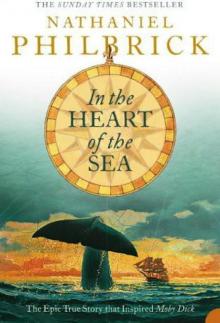 In the Heart of the Sea
In the Heart of the Sea The Last Stand
The Last Stand In the Hurricane's Eye
In the Hurricane's Eye